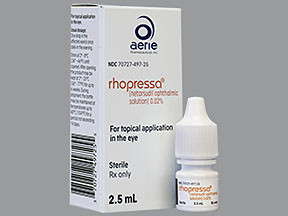NETARSUDIL SOLUTION - OPHTHALMIC
PHONETIC PRONUNCIATION: (ne-TAR-soo-dil)
COMMON BRAND NAME(S): Rhopressa
GENERIC NAME(S): netarsudil mesylate
Uses
USES: Netarsudil is used to treat high pressure inside the eye due to certain eye conditions (such as open-angle glaucoma, ocular hypertension). This medication is thought to work by increasing the flow of fluid out of the eye. This helps lower pressure inside the eye. Lowering high pressure inside the eye can help prevent loss of vision or blindness.
How to use NETARSUDIL SOLUTION - OPHTHALMIC
HOW TO USE: Apply this medication in the affected eye(s) as directed by your doctor, usually once a day in the evening. Do not use netarsudil more often because it may increase your risk for side effects. To apply eye drops, wash hands first. To avoid contamination, do not touch the dropper tip or let it touch your eye or any other surface. If you are wearing contact lenses, remove them before using eye drops. Wait at least 15 minutes before replacing your contact lenses. Tilt your head back, look upward, and pull down the lower eyelid to make a pouch. Hold the dropper directly over your eye and place one drop into the pouch. Look downward, gently close your eyes, and place one finger at the corner of your eye (near the nose). Apply gentle pressure for 1 to 2 minutes before opening your eyes. This will prevent the medication from draining out. Try not to blink or rub your eye. If directed to use this medication in both eyes, repeat these steps for your other eye. Do not rinse the dropper. Replace the dropper cap after each use. If you are using another kind of eye medication (such as drops or ointments), wait at least 5 minutes before applying other medications. Use eye drops before eye ointments to allow the drops to enter the eye. Use this medication regularly to get the most benefit from it. To help you remember, use it at the same time each day. Keep using netarsudil even if you feel well. Most people with glaucoma or high pressure in the eye do not have symptoms.
Side Effects
Precautions
Interactions
Overdose
Images
Reviews
Disclaimer
IMPORTANT: HOW TO USE THIS INFORMATION: This is a summary and does NOT have all possible information about this product. This information does not assure that this product is safe, effective, or appropriate for you. This information is not individual medical advice and does not substitute for the advice of your health care professional. Always ask your health care professional for complete information about this product and your specific health needs.

No Reviews Yet